  |
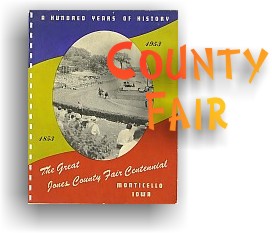 |
|||
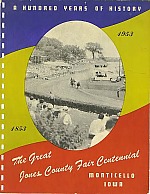
|
September 5th through 9th were the dates chosen for the Fair in 1892, which in commemoration of the 400th anniversary of the discovery of America was billed as the Jones County Columbian Exposition.
Since bicycles were still a novelty and therefore of much interest to fair crowds at the time, the fair association, anxious to please its patrons, offered $50 in prizes for bicycle races. Prizes consisted of a $20 free-for-all, a $15 Jones County purse and a special $15 prize for ladies. Most bicycles were the huge front wheel, tiny back wheel type, and to pilot one of these around the half-mile dirt track meant that the gasping, beet-red winners certainly earned their rewards. Catering to the dignity of the Fair patrons that year were tents erected by Lenox College, the Old Settlers' Association of the county, and the W. C. T. U. which checked parcels for a small fee and "heartily welcomed all callers." The 1892 Fair Board likewise let it be known that, "No gambling or fakirs will be allowed on the Jones County Fair grounds at Monticello. The fair, which always pays its premiums in full, depends on legitimate means for support and is always successful, where as, some of the neighboring fairs which reach for the dimes of the gamblers, lose the dollars of disgusted patrons." | |||
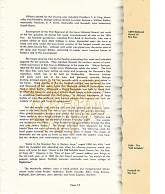 Officers elected for the ensuing year included: President, T. A. King, Monticello; Vice President, George Lathrop, Oxford Junction; Secretary, William Stuhler, Monticello; Treasurer, R. P. Smith, Monticello; and Marshall, Alex Sutherland, Scotch Grove. Officers elected for the ensuing year included: President, T. A. King, Monticello; Vice President, George Lathrop, Oxford Junction; Secretary, William Stuhler, Monticello; Treasurer, R. P. Smith, Monticello; and Marshall, Alex Sutherland, Scotch Grove.
Encampment of the First Regiment of the Iowa National Guard, just north of the fair grounds, all during fair week, overshadowed all else at the 1894 Fair. Six hundred guardsmen, including Ervin Reed of Monticello, who was a student officer at Iowa State College in Ames, descended upon the town to camp and drill, under the awe-struck scrutiny of the largest crowds yet seen at the Jones County Fair. Artesian well water was piped over the entire area of the camp and Young's Bakery contracted to supply seven hundred loaves of bread a day to the encampment. The troops came by train on the Sunday preceeding Fair week and unloaded opposite the fair grounds. They marched through the northern section of town, which was known at that time as Oklahoma, to the camp site. "Major Springer, reported the local paper, "made every Oklahoman salute the colors." The first few days they were busy setting up camp and preparing for Governor's Day inspection, which was to be held on Wednesday. Governor Jackson and party were met at the train and gloriously escorted through bunting arrayed streets to the fair grounds amid a seventeen gun salute in his honor. Dress parade of the six hundred soldiers was reviewed by him and thousands of fair goers, while five thousand rounds of ammunition were fired in sham battle. Afterward a Grand Reception was held in Floral Hall, at which the Governor and guard officers shook hands with everyone. "There is something, summarized the local paper, "in military movements of large bodies of men, the uniforms, and waving plums that inspires one with the majesty of power and force of government." But the novelty was wearing off, both for soldiers and citizenry. Comments in the little "Daily Fair News" ran "Don't josh the guards anymore . . . Who picked Bajasch's chickens and milked the cows on the north flats? . . . There seems to be a tough element in the military crowd . . . Profanity and revolver fire alarmed the residential districts Thursday night . . . Our women are insulted on the streets . . . They hunted strays (guardsmen) through the alley and coal cellars Friday." The troops enlivened their departure by firing blanks from the train windows at nervous citizens. The following week the local paper summed up the general feeling when it stated "The streets of Monticello are not quite so lively as they were while the soldiers were here. But the chickens and watermelons are safer now." "Come to the Greatest Fair in Eastern Iowa," urged 1896 fair bills, "and don't be inveigled into attending any other by alluring promises which you know will never be kept. Come to the Old Reliable Jones County Fair, the Peer of them all." Keeping it the "Peer of them all" meant adding new things to the old each year, so in 1896 the Fair Board arranged for "an exhibit of the popular college game, Football, between Monticello and Lenox College of Hopkinton" The Monticello athletes were a hand picked, but inexperienced eleven whose roster listed Prader, Hollenaur, Smith, Cassady, Rohn, King, Sweesy, Podhaski, Sam Johnson, John Johnson and Team Captain, Gardner. |

|
|||
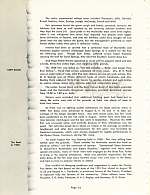
|
The cocky, experienced college team included Thompson, Mills, Dewald, Russel, Hopkins, Main, Dunlap, Joseph, McCready, French and Wolf.
Fair spectators found the game rough and keenly contested, however the Athletics had been so well coached by the towering Johnson brothers that they kept the score 0-0. Local pride in the Monticello team went even higher, when it was whispered that Lenox had imported two players from Upper Iowa University at Fayette, and that the Athletics could have bought off two Lenox men the day before the game, but the management preferred to meet honest defeat rather than glory in dishonest victory. Interest had been so spirited that a combined team of Monticello and Anamosa pigskin pushers challenged Sand Springs to a contest for the Fair the following year. Though Sam Greer, suffered severe facial fractures carrying the ball for Sand Springs, they beat the Southern County boys 6-4. And Major Noble Winner appeared as usual with his popcorn stand and also a bride, thirty-five inches high, and weighing forty pounds. The 1899 Fair was billed as "The Old Reliable - Better and Larger than Ever Before." Floral Hall entries surpassed all prior years. Mrs. D. E. Pond won on eight kinds of cake, Alex Rice took ribbons on nine art work entries, Mrs. G. H. George won on fifteen different types of artistic handwork, and Mrs. Bentley Clark captured thirty-three honors for garden produce and such entries as walnut catsup, lemon jelly, delicate cake and watermelon cake. The Ladies' Cornet Band and the Boys' Cornet Band of Monticello provided music and the Monticello Ministerial association provided devotional services from 12:30 to 1:00 p.m. daily. Patrons were reminded that additional hitching posts had been put in along the entire west side of the grounds so there was plenty of room to hitch their teams. As there was no lighting system satisfactory for large outdoor areas in 1899, Fair dates were advanced to August 8, 9, 10 and 11 to take advantage of the longer daylight hours. Not until recent years has fair week been established as the last full week in August. Earlier fairs were held any time between mid-August and the last week in September. However the 1899 Fair was unusually early, and partially because of that, attendance was not good. Fair activities closed down about six o'clock in the evenings as shadows lengthened, and after dark entertainment for fair goers was furnished by theatrical companies, which were always engaged for nightly performances in the Opera House downtown, during Fair week. An early August fair was likewise held in 1900. This time stifling heat settled upon the grounds. "Good weather for lemonade stands but hard on stand-up collars," ran the consensus of opinion. "Sensational Races between O. McCaffery's Automobile and Expert Bicyclists," together with many other special attractions, many of which were later engaged by the State Fair, failed to bring in the desired attendance. Heat was partially responsible, but the early dates of the Fair kept many farmers away who were busy in the fields, and had no time to prepare entries or attend. Ever mindful of changing conditions and suggestions to make the County Fair better, the Fair Board set the dates of the 1901 Fair ahead to August 20 to 23 and elected A. L. Fairbanks, a prominent farmer of the County, President to represent fully the farmers of the community. Other officers were: Vice President, E. G. Hicks; Treasurer, H. A. L. Bagley; and Secretary, O. R. Ricker. |
|||
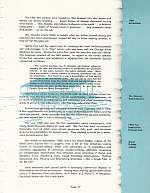 |
The 1901 Fair patrons were treated to "The Greatest Fair that Brains and Money can Devise including . . . Sweet Strains of Melody discoursed by big brass bands . . . Mrs. Murphy, only baboon balloonist in the world . . . A Midway Unequalled . . . Sights of Foreign Lands in profusion . . . and Mammoth Herds of Buffalo" - so ran the ads.
Mrs. Murphy nearly failed to appear after her balloon burned during one ascension but local seamstresses worked all day to finish making another, in time for her Thursday act. Sports fans had the opportunity of watching the much idolized baseball star and manager, A. C. "Cap" Anson, who had been with the Chicago White Stockings for years. During the entire Fair week the forty-five year old, retired first baseman umpired all the ball games. In regard to the varied interests of the Fair spectators and exhibitors, a clipping from the Monticello Express commented as follows:
One feature which made the Monticello park so ideal for the annual exposition, was the beautiful grassy natural amphitheatre. Here spectators sat on quilts or blankets to watch racing and attractions and often wandered from group to group to visit with friends, who they saw only at Fair time. Crowds kept growing and attractions became more elaborate, and in 1902, a new amphitheatre was constructed, at a cost of four thousand dollars and the track was graded. Many spectators felt that this limited the old time sociability, but they agreed that it was a necessary step. The year 1902 also saw the Fair Association newly incorporated, with nearly three thousand dollars of stock sold. The Fair had been so successful financially, that all debts were retired, premiums fully paid, and dividends given to the stockholders for several years. They decided to build for a better, more comprehensive Fair. |

| ||
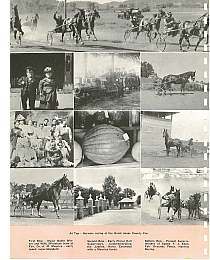 The middle of September, 1903, found the Great Golden Jubilee of the Great Jones County Fair in progress with a bill of free attractions costing twenty six hundred dollars, which were advertised as "A stupendous and marvelous aggregation of renowned, wander-working, celebrities comprising an unchallenged, phenomenal, free attraction array consisting of Aerial and Acrobatic Twins, Mystifying Feats, Laugh Provoking Knock-abouts, Thrilling Sensational Acts, Pleasing and Entertaining DiversitiesNot A Single Filler in the Big List!" The middle of September, 1903, found the Great Golden Jubilee of the Great Jones County Fair in progress with a bill of free attractions costing twenty six hundred dollars, which were advertised as "A stupendous and marvelous aggregation of renowned, wander-working, celebrities comprising an unchallenged, phenomenal, free attraction array consisting of Aerial and Acrobatic Twins, Mystifying Feats, Laugh Provoking Knock-abouts, Thrilling Sensational Acts, Pleasing and Entertaining DiversitiesNot A Single Filler in the Big List!"
Local merchants took special pride in arranging commercial displays in Floral Hall on this fiftieth anniversary. Among those making special observances were J. E. Bateman, Eilers and Bolton, W. F. Rohn, D. E. Pond, C. H. Schipman, The Lovell House and Owl Lunch Room. |
||||


© Copyright 1997-2013, The Art Department, © Copyright 2014-2020, Richard Harrison.
| ||||
